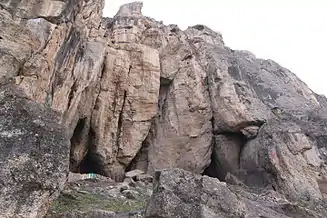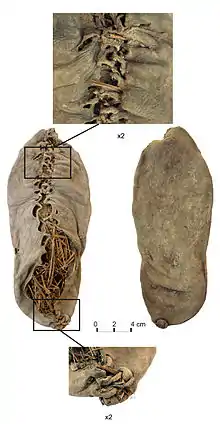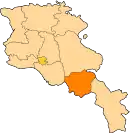Areni
Areni (Armenian: Արենի) is a village and the center of the Areni Municipality of the Vayots Dzor Province in Armenia. Areni is best known for its wine production, with the majority of wine produced locally from the nearby village of Getap.
Areni
Արենի | |
|---|---|
 | |
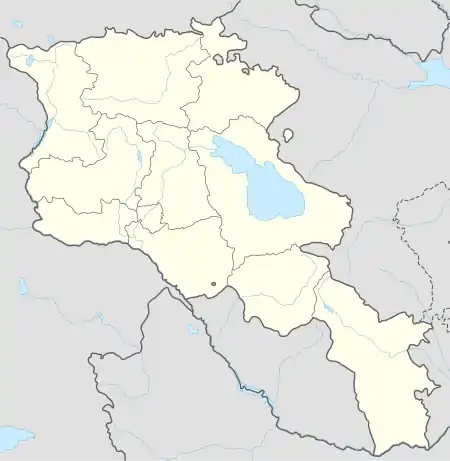 Areni | |
| Coordinates: 39°43′15″N 45°11′02″E | |
| Country | |
| Province | Vayots Dzor |
| Municipality | Areni |
| Elevation | 990 m (3,250 ft) |
| Population | |
| • Total | 1,772 |
| Time zone | UTC+4 (AMT) |
| Areni at GEOnet Names Server | |
The Astvatsatsin Church of Areni in the village, is a single-nave two-aisled domed Armenian church completed in the year 1321, and is located atop a plateau overlooking the Arpa River and Areni. The church was designed by the architect and sculptor Momik who is best known for his high-relief carvings at the monastery of Noravank (located approximately 6 kilometers southeast from Areni).
Nearby are also the 13th century ruins of lord Tarsaitch Orbelian of Syunik's palace, moved from Yeghegis to Areni during that time. Ruins of a 13th-century bridge built by Bishop Sarkis in 1265-1287 are one kilometer northeast of the church. At the same location are the remains of an older bridge.
Toponymy
The village was previously known as Arpa.
Nature
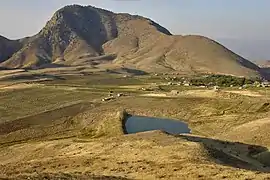
.jpg.webp)
Natural habitats include semi-desert, calcareous grasslands, and juniper woodlands alternated with cliffs, canyons, and rocky outcrops. Vicinity of Areni community have been considered as a Prime Butterfly Area,[2] where wide variety of rare butterflies, including Papilio alexanor, Colias chlorocoma, Colias aurorina, Pseudochazara schahrudensis, Tomares romanovi, Callophrys paulae, and number of others can be observed. Also the area is interesting for bird observations, being inhabited by Egyptian Vulture, White-throated Robin, Eastern Rock Nuthatch, Black-headed Bunting, and number of other species.[3]
Copper Age excavations
In 2007, an Armenian-Irish team decided to do test excavations in the cave site of Areni 1. Two test trenches in the front and rear galleries revealed Chalcolithic Age and Early Bronze Age layers dating back to 5000-4000 BCE. Excavations during 2007-2008 uncovered 3 pot burials in the rear chamber of the cave. Each pot contained a Copper Age human skull with no associated grave goods. All skulls belong to sub-adults of 9–16 years of age. These are currently being analyzed by the team's biological anthropologist. Remarkably, one skull contained a piece of a well-preserved brain tissue. This is the oldest known human brain from the Old World.
The cave has also offered surprising new insights into the origins of modern civilizations, such as evidence of a wine-making enterprise and an array of culturally diverse pottery. Excavations also yielded an extensive array of Copper Age artifacts dating to between 4,200 and 3,900 BCE. The new discoveries within the cave move early bronze-age cultural activity in Armenia back by about 800 years. Additional discoveries at the site include metal knives, seeds from more than 30 types of fruit, remains of dozens of cereal species, rope, cloth, straw, grass, reeds and dried grapes and prunes[4]
In January 2011 archaeologists announced the discovery of the earliest known winery, the Areni-1 winery, seven months after the world's oldest leather shoe, the Areni-1 shoe, was discovered in the same cave. The winery, which is over six-thousand years old, contains a wine press, fermentation vats, jars, and cups. Archaeologists also found grape seeds and vines of the species Vitis vinifera. Patrick McGovern, a biomolecular anthropologist at the University of Pennsylvania, commenting on the importance of the find, said, "The fact that winemaking was already so well developed in 4000 BC suggests that the technology probably goes back much earlier."[5][6]
Novel
In August 2014, a fiction alternative history novel entitled Origins: Discovery was released that featured the village of Arpa (which was renamed Areni in the late 1930s) during the period 1930 until 1952, and the Areni-1 Cave.
Gallery
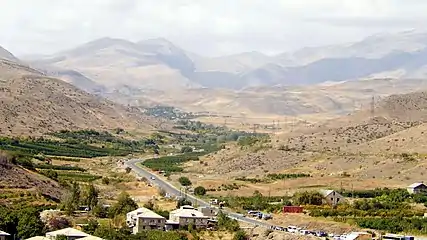 View of Areni
View of Areni Areni Wine Festival
Areni Wine Festival.jpg.webp) St. Astvatsatsin Church of 1321
St. Astvatsatsin Church of 1321 View of Areni
View of Areni.jpg.webp) Vineyard in Areni
Vineyard in Areni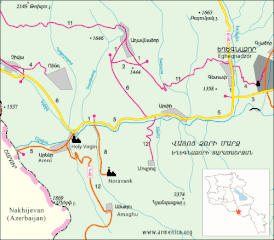 Map of Areni and surrounding region
Map of Areni and surrounding region
References
- Statistical Committee of Armenia. "The results of the 2011 Population Census of the Republic of Armenia" (PDF).
- Gnisheek PBA at Butterfly Conservation Armenia
- "Birdwatching at Armenian Bird Census Council". Archived from the original on 2016-12-26. Retrieved 2017-05-27.
- See Bower, Bruce (January 12, 2009). "Armenian cave yields ancient human brain". www.sciencenews.org.
- "'Oldest known wine-making facility' found in Armenia". BBC. January 11, 2011. Retrieved 2011-01-11.
- Maugh II, Thomas H. (January 11, 2011). "Ancient winery found in Armenia". Los Angeles Times.
External links
| Wikimedia Commons has media related to Areni. |
- Report of the results of the 2001 Armenian Census, Statistical Committee of Armenia
- Kiesling, Brady (2005), Rediscovering Armenia: Guide, Yerevan, Armenia: Matit Graphic Design Studio
- Brady Kiesling, Rediscovering Armenia, p. 119; original archived at Archive.org, and current version online on Armeniapedia.org.
- Butterfly Conservation Armenia: Gnishik PBA. http://www.butterfly-conservation-armenia.org/gnisheek.html
- Armenian Bird Census Council: Birdwatching. https://web.archive.org/web/20161226055914/http://www.abcc-am.org/birdwatching.html
- Hin Areni Winery
